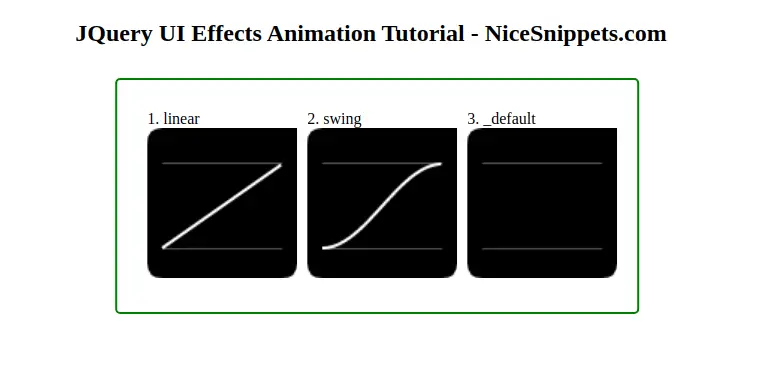11-Apr-2023
.
Admin

Hello Friends,
In this blog, I will learn you easing effect using jquery ui. How to perform easing effect using jquery ui.
jQueryUI Easing function is used to specify the rate of change of a parameter with respect to time. There are different types of easing functions in jQuery like linear, swing etc. Some easing provides their result in negative value during the animation.
Example
<!doctype html>
<html lang="en">
<head>
<meta charset="utf-8">
<meta name="viewport" content="width=device-width, initial-scale=1">
<title>jQuery UI Effects - Easing Example</title>
<link rel="stylesheet" href="https://code.jquery.com/ui/1.12.1/themes/base/jquery-ui.css">
<style>
canvas{
width:150px !important;
}
.graph{
width:150px !important;
float: left;
margin-left: 10px;
}
.main-class{
margin:-107px auto;
transform: translate(80%,50%);
border-radius: 5px;
padding:30px 20px;
border:2px solid green;
position: absolute;
}
</style>
<script src="https://code.jquery.com/jquery-1.12.4.js"></script>
<script src="https://code.jquery.com/ui/1.12.1/jquery-ui.js"></script>
</head>
<body>
<h2 style="text-align: center;">JQuery UI Effects Animation Tutorial - NiceSnippets.com</h2>
<div class="main-class">
<div id="graphs"></div>
</div>
<script>
$( function() {
if ( !$( "<canvas>" )[0].getContext ) {
$( "<div>" ).text(
"Your browser doesn't support canvas, which is required for this demo."
).appendTo( "#graphs" );
return;
}
var i = 0,
width = 100,
height = 100;
$.each( $.easing, function( name, impl ) {
var graph = $( "<div>" ).addClass( "graph" ).appendTo( "#graphs" ),
text = $( "<div>" ).text( ++i + ". " + name ).appendTo( graph ),
wrap = $( "<div>" ).appendTo( graph ).css( 'overflow', 'hidden' ),
canvas = $( "<canvas>" ).appendTo( wrap )[ 0 ];
canvas.width = width;
canvas.height = height;
var drawHeight = height * 0.8,
cradius = 10;
ctx = canvas.getContext( "2d" );
ctx.fillStyle = "black";
// Draw background
ctx.beginPath();
ctx.moveTo( cradius, 0 );
ctx.quadraticCurveTo( 0, 0, 0, cradius );
ctx.lineTo( 0, height - cradius );
ctx.quadraticCurveTo( 0, height, cradius, height );
ctx.lineTo( width - cradius, height );
ctx.quadraticCurveTo( width, height, width, height - cradius );
ctx.lineTo( width, 0 );
ctx.lineTo( cradius, 0 );
ctx.fill();
// Draw bottom line
ctx.strokeStyle = "#555";
ctx.beginPath();
ctx.moveTo( width * 0.1, drawHeight + .5 );
ctx.lineTo( width * 0.9, drawHeight + .5 );
ctx.stroke();
// Draw top line
ctx.strokeStyle = "#555";
ctx.beginPath();
ctx.moveTo( width * 0.1, drawHeight * .3 - .5 );
ctx.lineTo( width * 0.9, drawHeight * .3 - .5 );
ctx.stroke();
// Plot easing
ctx.strokeStyle = "white";
ctx.beginPath();
ctx.lineWidth = 2;
ctx.moveTo( width * 0.1, drawHeight );
$.each( new Array( width ), function( position ) {
var state = position / width,
val = impl( state, position, 0, 1, width );
ctx.lineTo( position * 0.8 + width * 0.1,
drawHeight - drawHeight * val * 0.7 );
});
ctx.stroke();
// Animate on click
graph.on( "click", function() {
wrap
.animate( { height: "hide" }, 2000, name )
.delay( 800 )
.animate( { height: "show" }, 2000, name );
});
graph.width( width ).height( height + text.height() + 10 );
});
});
</script>
</body>
</html>
It will help you...
#Jqury UI